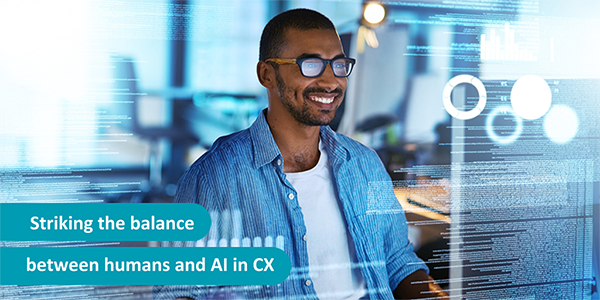Striking the balance between humans and AI in CX

By 2021, 15% of all customer service interactions will be completely handled by AI - an increase of 400% from 2017. And by 2022, 72% of interactions will involve an emerging technology such as machine-learning, chatbots or mobile messaging - up from 11% in 2017. These are just some of the stats quoted at a recent Gartner conference, in a presentation on the rise of AI and emerging technologies and how they will transform the customer experience.
The benefits are huge – for both consumers and brands. Customers will receive faster service and a more personalized experience, no matter how complex their query is. Automation will enable brands to be more efficient, scalable and cost-effective within their CX operations. Ultimately, brands will increase their bottom-line revenues, retaining and attracting customers by delivering a superior experience.
At the same time though, it’s important not to forget the human element in customer experience. Gartner’s predictions suggest for example that though the proportion of phone-based communication will drop from 41% to 12% of overall customer service interactions, a human agent will still be involved in 44% of all conversations.
Technology such as robotic automation and AI will eliminate some process-based tasks, but it will free up humans to spend more time on what they do best. Human agents will need to think creatively and collaboratively, solve complex problems and do more conversational, empathetic work. This means that agents will require different skills and expertise, but that their jobs will be more challenging, and rewarding.
Creating a balance between AI and humans
So, customer experience requires a mix of technology and the human touch. Successfully creating this will be key to success. In a whitepaper written for Eptica, CX expert Regine Vanheems recommends that brands look at the customer experience as a line – at one end is full automation and the other full human contact. Different types of interactions will be located along this line. For example, finding out answers to basic questions (such as returns policies for a retailer) could be handled through AI-based self-service or a chatbot, while others that require empathy and personalization should be delivered by humans. Consumers will also the process to be seamless – they won’t want to repeat themselves when they move from humans to technology.
At the same time, AI can augment the human skills that agents have, empowering them to do their jobs better. A good example of this is Natural Language Processing (NLP) technology, which analyses incoming interactions, routes it to the right agent and helps them understand the context of queries, as well as providing automatic access to relevant answers.
So how do you go about striking the right balance between AI and humans?
Here are four key considerations to think about:
- Ensure that you pick the right use cases for AI – play to its strengths and don’t try to replace roles that are best addressed by human agents
- Keep humans in the loop - for example, they need to be involved in training machine learning algorithms that are automating parts of the experience. And they need to be there so that problems can be escalated to them when the tech is not able to do what’s required to the customer’s satisfaction
- Manage the relationship between humans and AI so that it’s easy for customers to switch seamlessly between the two
- Focus on knowledge management – ensure the same knowledge powers both the AI tools and the human agents, and is constantly updated.
Ultimately those who will win at CX will be those who effectively marry emerging technology with the human touch. They should still be able to precisely meet the target needs and wants of customers, to reflect your brand personality when interacting with a consumer, (even if through a chatbot) - and be able to differentiate themselves through the range of options they provide. They should also be able to capture all the data collected through interactions – and act on it to constantly improve the experience. Finally, they should be able to automate knowledge management through machine learning.
In conclusion, it’s going to be extremely important to go beyond the hype around these new technologies. You have to understand where things like AI and NLP, for example, can help transform your operations and use it to meet customer needs as well as support agents and increase efficiency going forward. But the future of customer experience is very much about balancing technology with the human element.






